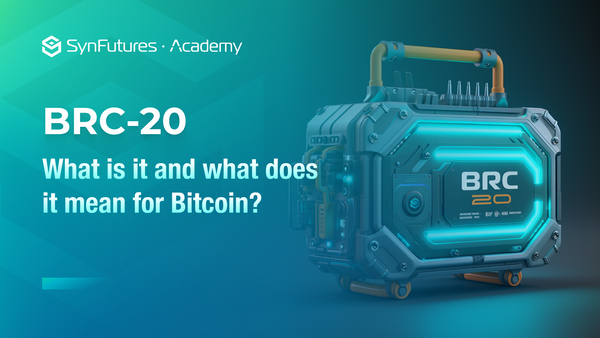What is arbitrage and how to arbitrage on SynFutures? – From the very basics
(Click here to skip the introduction and jump to the “how to” part.)
Key takeaways:
This article introduces a few strategies to arbitrage on SynFutures:
- Trade-hold-close: make a trade on SynFutures, hold it, close the position when the Fair Price and Spot Price approach.
- Trade-hold: make a trade on SynFutures, hold the position until expiration.
- Futures + Spot: trade futures on SynFutures and do the opposite spot trade.
- Futures from different markets – trade one contract on SynFutures and make an opposite trade on the same contract from a different trading platform.
- Futures with different expiration - make two opposite trades on the same asset pair but with different expiration.
Arbitrating on SynFutures is a very low-risk way to make profits, still, traders should do their own research before making the trades.
Introduction
Arbitraging sometimes can be confusing. While in theory, the concept should be easy to understand, in reality, it can get complicated very quickly, especially when futures trading is involved. This article is intended to use the simplest language to explain what arbitrage is and how to arbitrage on SynFutures. The “how to” part is heavily padded with examples, making financial language to be more… human-friendly.
First things first, what is arbitrage?
Arbitrage is the practice of buying and selling the same assets to take advantage of different prices. For example, a trader can buy an asset in one marketplace with a low price and quickly sell the same asset in another marketplace with a higher price to lock the difference as profit. Those who perform arbitrage are called arbitrageurs.
The necessary condition for arbitrage to happen is that the same asset does not trade at the same price on all markets. This is due to inefficiencies in the market. A perfectly efficient market would present no arbitrage opportunities as all assets would have the same prices across all marketplaces. As a matter of fact, arbitraging is a fundamental force to prevent different markets from creating significant price disparities on the same or similar assets.
In principle, arbitrage is a risk-free way to capitalize on the temporary price difference. Yet, arbitrageurs should still be aware of the transaction costs because if costs are prohibitively high, they may neutralize the gains or even cause losses from these trades. Another thing that traders should keep in mind is that arbitraging bots are running on all kinds of markets. The bots work far quicker than humans, leaving few opportunities for regular traders to profit, and can present risks to regular traders depending on the strategy and execution.
SynFutures v2, a decentralized futures trading protocol, has not attracted arbitraging bots’ attention, therefore still presents operatable arbitraging opportunities for regular traders from time to time. In this article, let’s look at the various ways of arbitraging on SynFutures v2 to earn “risk-free” profit.
A couple of basic nomenclatures
(Skip this section if you're already familiar with them.)
Before diving into arbitraging, let's get familiar with a few terms used on SynFutures that are important to know for arbitraging.
Fair Price: refers to the price calculated by AMM based on the quantities of the assets. SynFutures uses constant product AMM X * Y = K, where X and Y denote the quantity of asset x and y respectively, and K is a constant. The Fair Price of asset x is determined as Y/X. In the example shown above in image 1, x would be WETH, y is MATIC. The fair price of 2,177.9 means the quantity of MATIC is 2,177.9 times that of WETH. If traders come in and buy WETH with MATIC, Fair Price of the pair would rise because of the quantity change, and vice versa. The Fair Price determination mechanism of SynFutures is similar to most of the trading DEX AMM on the market.
Spot Price: refers to the asset price on a spot DEX. This price is fed to SynFutures by price oracles. Spot Price is like the stock price on Nasdaq or S&P 500, where the price reflects the value of the equity at that particular moment. Unlike stocks though, in cryptocurrency, the same asset might have minor price discrepancies on different spot DEXs. SynFutures employs different price oracles on different networks to ensure the effectiveness of spot price. For example, the WETH-MATIC pair shown in image 1 uses Sushi Swap’s spot price. In this example, the spot price of WETH-MATIC is 1805.2, meaning 1 WETH is worth of 1805.2 MATIC on Sushi Swap at the moment the price was captured.
Margin: refers to the collateral in trading futures. The amount of margin is directly related to the leverage of the trading. For example, Alice wants to trade 1 WETH with MATIC. Instead of putting down 2,177.9 MATIC like in a spot DEX, Alice decides to use a 10x leverage, meaning she only needs to put down 217.79 MATIC as a margin to trade 1 WETH.
Margin asset is the asset that traders should own. In the WETH-MATIC pair, MATIC is the margin asset, meaning the traders need to own MATIC in their wallets in order to trade on SynFutures v2, but they are not required to own WETH. Similarly in ETH-USDC pair, traders are required to own USDC but not ETH, etc.
How to arbitrage on SynFutures?
OK, now that we have a good understanding of the basic concepts, here comes the fun part - How to arbitrage on SynFutures and lock in the profit?
First of all, for any arbitrage to work, there needs to be a price difference. SynFutures makes it super easy to tell if there are arbitraging opportunities or not because the Fair Price and Spot Price are displayed on the same page. In theory, as long as there is a price difference, traders can arbitrage. Yet, for beginners, it’s better to arbitrage when the price difference is big enough, say 5% and up.
Once opportunities show, there are several ways to arbitrage and lock in the profit.
- Trade-hold-close: make a trade on SynFutures, hold it, close the position when the Fair Price and Spot Price approach.
Using WETH-MATIC pair as an example again, the Spot Price is 1805.2, and the Fair Price is 2,177.9 – a price discrepancy of 20+%! A perfect arbitraging opportunity.
Alice, an arbitrageur spotted this opportunity, and here is what she is going to do using the trade-hold-close strategy.
- Short/Sell 1 WETH-MATIC-1231-SUSHI on SynFutures at the price of approximately 2,177.9.
- Hold it and keep an eye on the Fair Price movement.
- (Two hours later, Alice found the Fair Price has come down to 1805.9. This is because with enough arbitraging, Fair Price approaches Spot Price quickly.)
- Long/buy 1 the same pair WETH-MATIC-1231-SUSHI on SynFutures to close the position at approximately 1805.9 to lock in the profit.
Let’s do some simple math and calculate the profit.
The profit in this trade is:
Profit = (Short/Sell price – Long/Buy price) x position = (2177.9 – 1805.9) x 1 = 372 MATIC.
With the MATIC price of $2.41 (Coinbase price), that’s $896.52 risk-free money in a couple hours
Assuming Alice was aggressive, and used a 10x leverage (not recommended), meaning she deposited 217.79 MATIC as margin, the ROI of this arbitraging is:
ROI = profit / margin = 372 / 217.79 = 170.8%
APY (annual percentage yield) = (372 x (24/2) x 365)/217.79 = 748,133.52% !
Using lower leverage will decrease your ROI but won’t affect your profit. Alice would still make 372 MATIC (or $896.52) profit no matter the leverages she uses although the ROI will change as she’ll need to adjust the margin deposited for this trade.
Please note: With slippage, the settled price might be a bit different from Fair Price, but let’s ignore slippage for simplicity. All the following examples ignore slippage too unless otherwise specified.
2. Trade-hold: make a trade on SynFutures, hold the position until expiration.
Assuming Bob, who also spotted the price discrepancy of WETH-MATIC-1231-SUSHI, expects the spot price of WETH-MATIC will continue to fall. Instead of closing the position and locking in the profits, he decides to hold the position and make more profits when the contract expires. Here is what he is going to do.
- Short/Sell 1 WETH-MATIC-1231-SUSHI on SynFutures at the price of approximately 2,177.9.
- Hold it.
That’s it!
Assuming the spot price of the pair drops to 1,500 at expiration (to Bob’s wish), the contract will expire at the price of 1,500 no matter how the Fair Price would be (thanks to SynFutures pricing mechanism at expiry).
The profit Bob makes will be:
Profit = (Short/Sell price – Spot Price at expiry) x position = (2177.9 – 1500) x 1 = 617.9 MATIC, or $1,489.1 at today’s MATIC price.
The trade-hold strategy is the easiest of all and will probably make you the most profit. Still, it’s always great to keep an eye on the market. When market goes opposite direction as you expect it, use the first strategy: close the position before expiration and lock in the profits.
3. Futures + Spot: trade futures on SynFutures and do the opposite spot trade on a DEX or CEX.
Eve, also an arbitrageur wants to combine futures and spot to do arbitraging, because this strategy, theoretically, has even less risk. Here is what she is going to do.
- Short/Sell 1 WETH-MATIC-1231-SUSHI on SynFutures at the price of approximately 2,177.9.
- Buy 1 WETH with MATIC at the price of approximately 1,805.2 on Sushi Swap (or any other spot trading platform).
- (A couple of hours later, Fair Price has come down to 1805.9 on SynFutures)
- Long/Buy 1 WETH-MATIC-1231-SUSHI on SynFutures at the price of approximately 1805.9 to close the position and lock in the profit.
- Go to Sushi Swap (or wherever the spot trade happened) and sell 1 WETH for MATIC at the price of approximately 1,805.2.
The profit of Eve’s trade is the same as Alice’s since Eve does not make or lose money from the spot trading (amid fees). Eve did the extra steps of trading on the spot to prevent possible losses due to large price swings to the unfavored direction during trading. However, in reality, Eve needs to pay fees for the spot trading, which takes away part of her profit.
4. Futures from different markets – trade one contract on SynFutures and make an opposite trade on the same contract from a different trading platform.
Trent noticed that the WETH-USDT pair expiring on Dec. 31 is trading at 4,422.4 on SynFutures but on Binance, it is trading at 4300.63 (shown in the above pictures). He decides to arbitrage. Here is what he is going to do:
- Short/Sell 1 WETH-USDT-1231-SUSHI on SynFutures at the price of approximately 4,422.4.
- At the same time, Long/Buy 1 ETHUSDT on Binance at the price of 4300.63.
- Hold the contract to expiration.
(Note: WETH-USDT-1231-SUSHI on SynFutures is the same contract as ETHUSDT Quarterly futures expiring on Dec. 31. The notation is different because every platform has its own way of notating contracts.)
This immediately results in an arbitrage spread of 121.77 USDT (2.8%), and this profit is safely booked no matter how the market moves. The long and short position offsets each other. In the meantime, holding the contracts to expiry basically ensures the combination of both contracts will expiry at few to zero losses or gains. The total profit would be the immediate profit at the time of making the trades.
5. Futures with different expiration - make two opposite trades on the same asset pair but with different expiration.
Mallory spotted on SynFutures that the WETH-USDC pair have different Fair Prices on different expirations (shown above). So, she decides to arbitrage. Here is what she is going to do:
- Long/Buy 1 WETH-USDC-1231-SUSHI at approximately 4292.4.
- Short/Sell 1 WETH-USDC-0107-SUSHI at approximately 4,351.2.
This immediately results in an arbitrage spread of 58.8 USDC (1.4%) and Mallory earned it without exposing herself to the volatile market.
This strategy is usually used by institutions or experienced traders. Beginners are not advised to try this strategy as it involves more complex risk managing strategies behind.
Closing
Arbitrage is a great option for crypto investors to make very low-risk returns. SynFutures v2 often presents arbitraging opportunities for traders and community members to take advantage of. By spotting arbitrage opportunities on SynFutures and capitalizing on them, traders make decisions on the expectation of generating fixed profit without necessarily analyzing market sentiments or relying on other predictive pricing strategies. Also, depending on the arbitraging efficiency, it is possible to enter and exit an arbitrage trade in seconds or minutes, making the returns to be very time efficient.
Although arbitraging is very low risk, in reality, it is not risk-free. Leverage management is one of the key things to avoid risk when arbitraging on SynFutures. Always apply leverage responsibly, and actively manage the account margin.
Read more: A step-by-step guide to earn as a SynFutures arbitrageur. How SynFutures v2 work?
Discover SynFutures' Crypto Derivatives products: www.synfutures.com/.
Disclaimer: SynFutures Academy does not guarantee the reliability of the site content and shall not be held liable for any errors, omissions, or inaccuracies. The opinions and views expressed in any SynFutures Academy article are solely those of the author(s) and do not reflect the opinions of SynFutures. The SynFutures Academy articles are for educational purposes or information only. The information provided on the site does not constitute an endorsement of any of the products and services discussed or investment, financial, or trading advice. A qualified professional should be consulted prior to making financial decisions.




